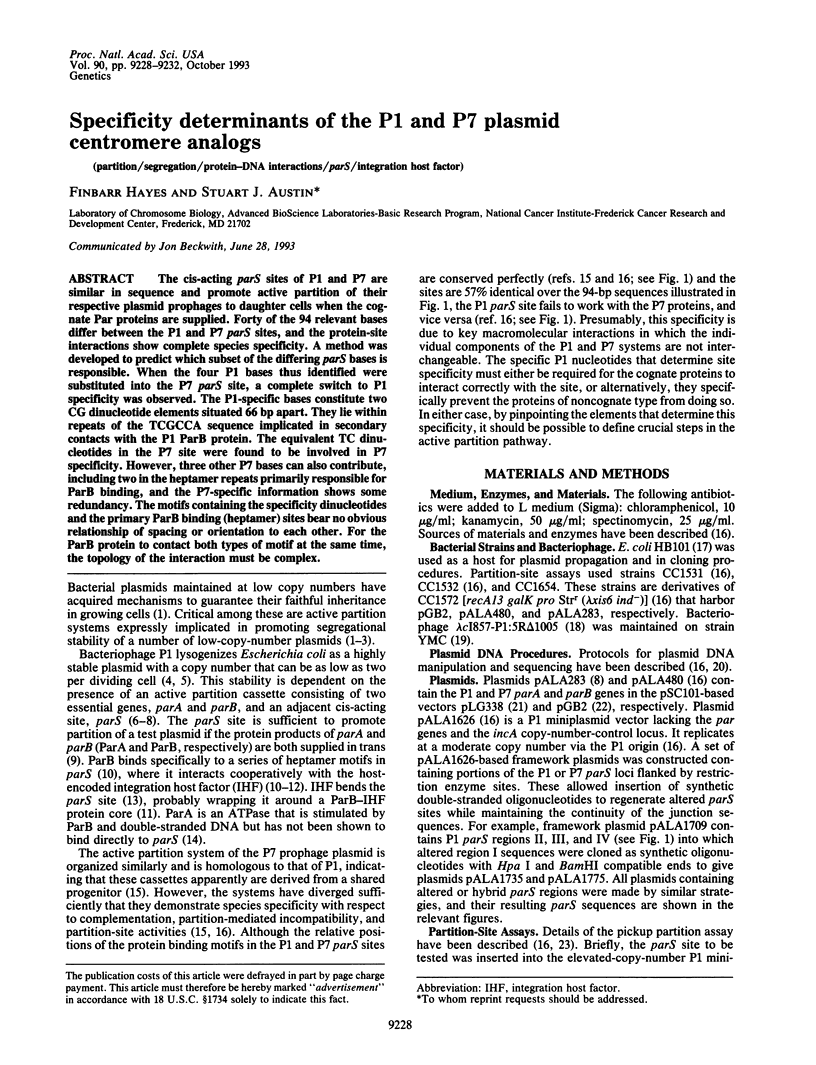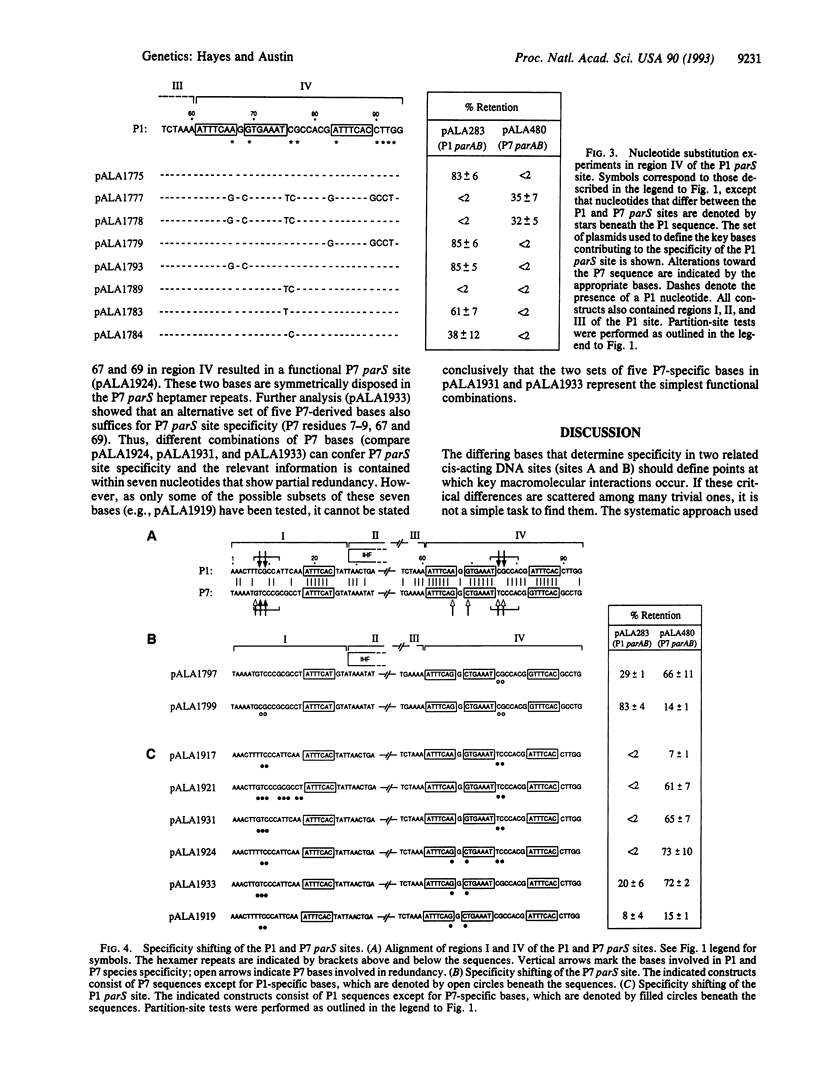Abstract
The cis-acting parS sites of P1 and P7 are similar in sequence and promote active partition of their respective plasmid prophages to daughter cells when the cognate Par proteins are supplied. Forty of the 94 relevant bases differ between the P1 and P7 parS sites, and the protein-site interactions show complete species specificity. A method was developed to predict which subset of the differing parS bases is responsible. When the four P1 bases thus identified were substituted into the P7 parS site, a complete switch to P1 specificity was observed. The P1-specific bases constitute two CG dinucleotide elements situated 66 bp apart. They lie within repeats of the TCGCCA sequence implicated in secondary contacts with the P1 ParB protein. The equivalent TC dinucleotides in the P7 site were found to be involved in P7 specificity. However, three other P7 bases can also contribute, including two in the heptamer repeats primarily responsible for ParB binding, and the P7-specific information shows some redundancy. The motifs containing the specificity dinucleotides and the primary ParB binding (heptamer) sites bear no obvious relationship of spacing or orientation to each other. For the ParB protein to contact both types of motif at the same time, the topology of the interaction must be complex.
Full text
PDF




Selected References
These references are in PubMed. This may not be the complete list of references from this article.
- Abeles A. L., Friedman S. A., Austin S. J. Partition of unit-copy miniplasmids to daughter cells. III. The DNA sequence and functional organization of the P1 partition region. J Mol Biol. 1985 Sep 20;185(2):261–272. doi: 10.1016/0022-2836(85)90402-4. [DOI] [PubMed] [Google Scholar]
- Austin S., Abeles A. Partition of unit-copy miniplasmids to daughter cells. I. P1 and F miniplasmids contain discrete, interchangeable sequences sufficient to promote equipartition. J Mol Biol. 1983 Sep 15;169(2):353–372. doi: 10.1016/s0022-2836(83)80055-2. [DOI] [PubMed] [Google Scholar]
- Austin S., Hart F., Abeles A., Sternberg N. Genetic and physical map of a P1 miniplasmid. J Bacteriol. 1982 Oct;152(1):63–71. doi: 10.1128/jb.152.1.63-71.1982. [DOI] [PMC free article] [PubMed] [Google Scholar]
- Boyer H. W., Roulland-Dussoix D. A complementation analysis of the restriction and modification of DNA in Escherichia coli. J Mol Biol. 1969 May 14;41(3):459–472. doi: 10.1016/0022-2836(69)90288-5. [DOI] [PubMed] [Google Scholar]
- Churchward G., Belin D., Nagamine Y. A pSC101-derived plasmid which shows no sequence homology to other commonly used cloning vectors. Gene. 1984 Nov;31(1-3):165–171. doi: 10.1016/0378-1119(84)90207-5. [DOI] [PubMed] [Google Scholar]
- Davis M. A., Martin K. A., Austin S. J. Biochemical activities of the parA partition protein of the P1 plasmid. Mol Microbiol. 1992 May;6(9):1141–1147. doi: 10.1111/j.1365-2958.1992.tb01552.x. [DOI] [PubMed] [Google Scholar]
- Davis M. A., Martin K. A., Austin S. J. Specificity switching of the P1 plasmid centromere-like site. EMBO J. 1990 Apr;9(4):991–998. doi: 10.1002/j.1460-2075.1990.tb08201.x. [DOI] [PMC free article] [PubMed] [Google Scholar]
- Dennert G., Henning U. Tyrosine-incorporating amber suppressors in Escherichia coli K12. J Mol Biol. 1968 Apr 14;33(1):327–329. doi: 10.1016/0022-2836(68)90300-8. [DOI] [PubMed] [Google Scholar]
- Funnell B. E., Gagnier L. The P1 plasmid partition complex at parS. II. Analysis of ParB protein binding activity and specificity. J Biol Chem. 1993 Feb 15;268(5):3616–3624. [PubMed] [Google Scholar]
- Goodrich J. A., Schwartz M. L., McClure W. R. Searching for and predicting the activity of sites for DNA binding proteins: compilation and analysis of the binding sites for Escherichia coli integration host factor (IHF). Nucleic Acids Res. 1990 Sep 11;18(17):4993–5000. doi: 10.1093/nar/18.17.4993. [DOI] [PMC free article] [PubMed] [Google Scholar]
- Hayes F., Davis M. A., Austin S. J. Fine-structure analysis of the P7 plasmid partition site. J Bacteriol. 1993 Jun;175(11):3443–3451. doi: 10.1128/jb.175.11.3443-3451.1993. [DOI] [PMC free article] [PubMed] [Google Scholar]
- Ludtke D. N., Eichorn B. G., Austin S. J. Plasmid-partition functions of the P7 prophage. J Mol Biol. 1989 Oct 5;209(3):393–406. doi: 10.1016/0022-2836(89)90005-3. [DOI] [PubMed] [Google Scholar]
- Martin K. A., Davis M. A., Austin S. Fine-structure analysis of the P1 plasmid partition site. J Bacteriol. 1991 Jun;173(12):3630–3634. doi: 10.1128/jb.173.12.3630-3634.1991. [DOI] [PMC free article] [PubMed] [Google Scholar]
- Martin K. A., Friedman S. A., Austin S. J. Partition site of the P1 plasmid. Proc Natl Acad Sci U S A. 1987 Dec;84(23):8544–8547. doi: 10.1073/pnas.84.23.8544. [DOI] [PMC free article] [PubMed] [Google Scholar]
- Nordström K., Austin S. J. Mechanisms that contribute to the stable segregation of plasmids. Annu Rev Genet. 1989;23:37–69. doi: 10.1146/annurev.ge.23.120189.000345. [DOI] [PubMed] [Google Scholar]
- Prentki P., Chandler M., Caro L. Replication of prophage P1 during the cell cycle of Escherichia coli. Mol Gen Genet. 1977 Mar 28;152(1):71–76. doi: 10.1007/BF00264942. [DOI] [PubMed] [Google Scholar]
- Stoker N. G., Fairweather N. F., Spratt B. G. Versatile low-copy-number plasmid vectors for cloning in Escherichia coli. Gene. 1982 Jun;18(3):335–341. doi: 10.1016/0378-1119(82)90172-x. [DOI] [PubMed] [Google Scholar]


